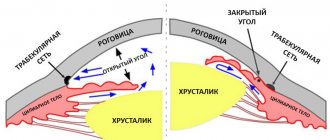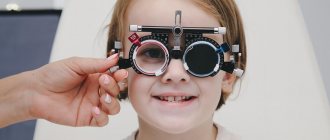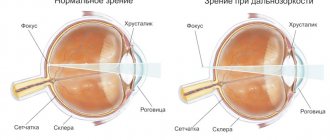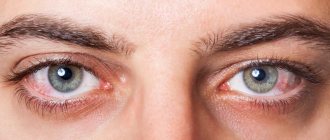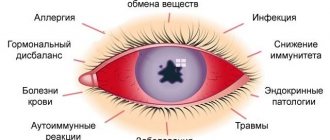Diplopia is doubling of the image. Typically, this condition is called double vision. Diplopia is not a disease, but a symptom, and identifying and treating its cause will help you restore normal vision.
- What is diplopia?
- Causes and complications of diplopia
- Diagnosis and treatment of diplopia
Dry eyes and diplopia: is there a connection?
The causes of double vision can be various diseases and pathologies. The following factors contribute to the development of monocular diplopia:
- Astigmatism. A vision defect that occurs due to changes in the shape of the cornea, lens, and eyeball. Against the background of this pathology, the clarity of vision decreases.
- Keratoconus. An ophthalmological disease that is characterized by thinning and curvature of the cornea (becomes cone-shaped).
- Pterygium. The formation of a pterygoid hymen on the conjunctiva, which grows into the cornea.
- Cataract. Decreased transparency (clouding) of the lens, leading to partial or complete blindness.
- Dry eye syndrome. A pathological condition caused by disruption of the stability of the tear film. Most often it occurs due to a decrease in the amount of tear fluid produced.
Binocular diplopia indicates that the eyes have lost the ability to work in pairs. Therefore, the reasons for its development must be sought in other organs, namely in the brain and nervous system. Most often, the pathological condition occurs against the background of such diseases:
- diabetes mellitus (causes damage to nerve structures);
- myasthenia gravis (pathological weakness of the eyelids);
- strabismus;
- diffuse toxic goiter (thyroid disease);
- cranial nerve palsy;
- inflammatory damage to the optic nerves.
Diplopia that occurs against the background of dry eye syndrome or other pathologies can lead to the development of complications. Many patients experience dizziness, nausea, photosensitivity, and visual strain due to double vision.
How does double vision manifest?
When objects appear double, their images may appear side by side or overlap each other. Often, double vision changes depending on the direction of view and tilt of the head, occurs when turning the head to the side, etc. At the same time, it is usually divided into:
- Monocular, in which double vision persists when one eye is closed.
- Binocular double vision occurs when a person looks with both eyes, and when one of them is closed, it disappears. In this case, the image doubles either horizontally or vertically.
There is also physiological diplopia. With binocular vision, only the object on which the gaze is focused does not double. Objects located closer or further from the point of fixation of the gaze may appear double. Typically, the brain suppresses double images so we don't notice them. It is true that children often have the ability to see the splitting of objects without fixing their gaze. In this case, they usually complain of double vision.
There are a great many reasons why double vision occurs, ranging from completely insignificant to serious conditions that threaten human life.
How to get rid of diplopia?
Only a specialist knows how to treat diplopia. But in order to understand why there is double vision, you need to undergo a comprehensive diagnosis. It includes an eye examination, blood sugar level determination, and an MRI or CT scan of the vision organ. This allows you to determine the cause of the visual defect and select rational treatment.
As part of therapy, a specialist may recommend special exercises, wearing a bandage, corrective lenses, and glasses. In difficult cases, diplopia of the eye is treated surgically.
The development of pathology can be prevented by minimizing the impact of negative factors on the organ of vision. First of all, it is necessary to prevent the development of dry eye syndrome, which can cause monocular diplopia.
Will tear substitutes help eliminate dry eyes and diplopia?
The key treatment for dry eye syndrome is eye drops that mimic tears. They have a composition close to native tears and help compensate for the lack of hydration. But drops are not a panacea for dry eyes and diplopia, but only a temporary solution to the problem.
None of the existing tear substitutes can eliminate the true causes of dry eyes. The drops do not in any way affect the functioning of the lacrimal apparatus, so they can only temporarily eliminate the unpleasant symptoms of dry eye syndrome, but not the causes of the disease.
In addition, the use of such drugs can lead to its progression. The fact is that frequent instillation of drops helps to wash out important components of tears from the conjunctival cavity. Therefore, their composition changes, the tear film becomes unstable and dries quickly. Because of this, dry eye disease begins to progress, which threatens corneal perforation.
Some drugs can even be dangerous to eye tissue. We are talking about drops with preservatives, which extend the shelf life of the drops, but cause the destruction of goblet cells (they produce an important component of tears - mucin). Therefore, when using tear substitutes with preservatives, there is a risk of rapid progression of dry eye syndrome and the development of diplopia.
Blurred vision in one or both eyes
Blurry vision is when your vision loses its sharpness and instead of seeing a clear picture, you see a cloudy image. Objects seem to be out of focus and have blurry outlines.
It is quite logical that such a problem causes concern. There are many reasons for blurry vision. This can be myopia, farsightedness, astigmatism, presbyopia, all these vision problems are related to refractive error. Sometimes loss of picture clarity can be evidence of dangerous diseases and neurological disorders that cannot be ignored.
If you have problems with your vision, the first thing we do is go to the doctor, he will check your eyes in all respects and determine whether treatment is needed. It is very important to have your eyes examined comprehensively.
Causes of loss of vision clarity and how to cure it
Myopia or myopia: In this case, you feel excessive tension in your eyes, even causing headaches. Strabismus and blurred vision may appear in one eye or both.
Treatment options include wearing glasses, contact lenses, surgical methods such as LASIK or photorefractive keratectomy.
Farsightedness: in this case, you can see objects in the distance perfectly, but not up close. To look at an object up close, you have to strain your eyes. In this case, the eyes become very tired. Treatment options are similar to myopia - glasses, contact lenses or refractive eye surgery.
Astigmatism: If you have trouble seeing objects both near and far, this may be a sign of astigmatism. Its cause is the deformed shape of the cornea.
In this case, the light rays are not focused on the retina, which means that a clear picture does not form; the distance to the object in this case does not matter.
Treatment methods: glasses, contact lenses, surgery.
Presbyopia: This disease is a consequence of the natural aging of the body. And if your age has exceeded the mark of forty years, do not be surprised that you find it difficult to read text messages on your phone or the small print on the packaging. As a treatment, your doctor may prescribe glasses to correct refractive errors and presbyopia. Additional options in glasses such as anti-reflective coating and photochromic lenses are very important. For more information about the best glasses to choose, talk to your eye doctor.
Chronic Dry Eye Syndrome: If your eyes often become dry, this may cause your vision to become blurred from time to time. As a treatment for this disease, your doctor will recommend you artificial tears - these are drops that have a lubricating effect. If the situation is very serious, then the doctor will prescribe prescription medications or special plugs inserted into the lacrimal canal - they have several names - obturators, punctal occluders.
Pregnancy: When a woman is expecting a baby, her body often produces surprising reactions, including vision problems - blurred vision or double vision. Hormones are to blame for everything - they can influence the shape and thickness of the cornea. All this leads to blurry vision. Often, blurred vision is a consequence of dry eyes, which also often happens during pregnancy.
Ocular migraines or migraine headaches:
Migraine is an extremely unpleasant condition, but not dangerous in general. Symptoms include the appearance of a veil before the eyes, flickering light and luminous zigzags.
Floaters: You may experience vision problems when some strange floaters float in front of your eyes. Very often, this problem appears with age: the gel-like vitreous body of the eye loses its dense structure over the years and becomes more liquid. Tiny pieces of tissue inside it float freely around the eye and cast shadows on the retina, which is why we see floating objects.
Blurred vision after LASIK surgery: After refractive surgery, your vision may be blurry. But this unpleasant effect goes away after a few days. However, it will take a little longer for your vision to return to normal.
Eye drops and medications: the cause of blurred vision, as well as eye irritation, can be eye drops, or rather the preservatives that are included in their composition. Dry eyes and blurred vision may result from the use of histamines. These side effects are usually indicated in the instructions for the medications. If you don't know why your vision is blurry, you can ask your doctor, and he will find out if it is a “side effect” from any medications.
Uncontrolled wearing of contact lenses: Usually you can wear lenses for a short period of time, this period is indicated on the lenses themselves, but very often we neglect these recommendations. If you wear contact lenses for too long, dirt, including protein, accumulates in them. Not only can this cause blurred vision, but it can also cause an eye infection.
Blurred vision as a symptom of dangerous vision problems
Eye diseases: If you are over 60 years old and feel that your vision is suddenly blurred, you are at risk of developing a macular hole - a retinal tear. The consequence of many eye diseases can be irreversible loss of vision, so you should immediately go to the hospital if you feel that your vision has sharply deteriorated.
Cataract: This disease is dangerous because if left untreated, you can go completely blind. Symptoms of cataracts are blurred vision, glare and halos around the light at night, the solution is cataract surgery and an artificial lens. These surgeries will restore lost vision.
Glaucoma: symptoms are blurred vision and tunnel vision. It is very important to start treatment on time, otherwise you may completely lose the ability to see.
Age-related macular degeneration: With this disease, you suffer not so much from blurry images, but from the fact that the image becomes distorted - straight lines become waves or become choppy. This age-related disease is again dangerous because you can become completely blind.
Diabetic Retinopathy: Diabetes can lead to diabetic retinopathy, which is a dangerous disease that causes severe damage to the retina of the eye.
Cardiovascular diseases and other systemic diseases: blurred vision can be a signal of the onset of an extremely dangerous disease such as a stroke or cerebral hemorrhage. This could also be the first sign of multiple sclerosis. Therefore, if you suddenly feel that your vision has lost clarity or you are seeing double, you should immediately seek medical help.
Source: https://www.allaboutvision.com/conditions/blurry-vision.htm
Blurry vision in one or both eyes
Aimee Rodriguez; tested by optometrist Gary Heiting
Delfanto® – an innovative product for restoring tear fluid production
Delfanto® capsules are a modern product based on a standardized extract of Aristotelia chilean (MaquiBright®). It contains at least 35% polyphenolic anthocyanins, which help eliminate the effects of oxidative stress and make the tear glands work stably.
Unlike tear substitutes, Delfanto® eliminates not only the signs of dry eye syndrome, but also the causes. The product stimulates the production of your own tears, which provides protection, nutrition, and hydration of eye tissue. Already 14 days after the start of the course of therapy, the first positive changes are noticeable, and after a month, the manifestation of dry eye symptoms is reduced by 45-89% (according to the results of clinical studies).
